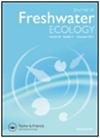Distribution and diversity of benthic macroinvertebrates in the Mohlapitsi River, South Africa
IF 1.4
4区 环境科学与生态学
Q3 ECOLOGY
引用次数: 7
Abstract
Abstract Freshwater ecosystems are facing degradation from human activities in the form of alterations of flow regimes, changes in land-use, and intensive water abstraction, in turn generating adverse effects on biodiversity and ecological functionality. Efficient assessment of river/stream ecosystem response to such anthropogenic changes is urgently needed. Many human activities that have an effect on water quality and river health are increasing along the Mohlapitsi River, which used to be one of the rivers with good water quality in South Africa. The aim of the study was to assess spatial variation in macroinvertebrate assemblages in relation to water quality of the Mohlapitsi River. A combination of canonical correspondence analysis and univariate analyses were used to examine the macroinvertebrate assemblages at six different sites of the Mohlapitsi River. The spatial difference in macroinvertebrate abundance was mostly related to changes in water quality. The number of taxa and the diversity of macroinvertebrates remained relatively high across the river as compared to other rivers in the Olifants River System. The midstream and downstream sites were mostly dominated by macroinvertebrates tolerant to disturbance/pollution. The most abundant family was the Thiaridae (about 60%) and mainly occurred in the midstream and downstream sites of the river (more disturbed sites). The study showed a higher evenness index in the upstream than the midstream and downstream sites which is an indication of good water quality at the upstream sites of the river. The results suggest that the river is being subjected to a moderate environmental pollution, which requires continuous assessment and monitoring to determine causes and initiate remedial measures.南非Mohlapitsi河底栖大型无脊椎动物的分布和多样性
摘要淡水生态系统正面临着人类活动造成的退化,表现为流态的改变、土地利用的变化和密集的取水,从而对生物多样性和生态功能产生不利影响。迫切需要对河流/溪流生态系统对这种人为变化的反应进行有效评估。Mohrapitsi河曾是南非水质良好的河流之一,许多对水质和河流健康有影响的人类活动正在增加。本研究的目的是评估大型无脊椎动物组合与Mohrapitsi河水质之间的空间变化。采用规范对应分析和单变量分析相结合的方法,对莫赫拉皮茨河六个不同地点的大型无脊椎动物组合进行了研究。大型无脊椎动物丰度的空间差异主要与水质变化有关。与Olifants河系的其他河流相比,河流中大型无脊椎动物的分类群数量和多样性仍然相对较高。中游和下游地区主要是耐受干扰/污染的大型无脊椎动物。最丰富的家族是Thiaridae(约60%),主要分布在河流的中下游地区(受干扰的地区较多)。研究表明,上游的均匀度指数高于中游和下游,这表明河流上游的水质良好。结果表明,该河正受到中度环境污染,需要持续评估和监测,以确定原因并采取补救措施。
本文章由计算机程序翻译,如有差异,请以英文原文为准。
求助全文
约1分钟内获得全文
求助全文
来源期刊
CiteScore
2.20
自引率
7.70%
发文量
34
审稿时长
3 months
期刊介绍:
The Journal of Freshwater Ecology, published since 1981, is an open access peer-reviewed journal for the field of aquatic ecology of freshwater systems that is aimed at an international audience of researchers and professionals. Its coverage reflects the wide diversity of ecological subdisciplines and topics, including but not limited to physiological, population, community, and ecosystem ecology as well as biogeochemistry and ecohydrology of all types of freshwater systems including lentic, lotic, hyporheic and wetland systems. Studies that improve our understanding of anthropogenic impacts and changes to freshwater systems are also appropriate.

 求助内容:
求助内容: 应助结果提醒方式:
应助结果提醒方式:


